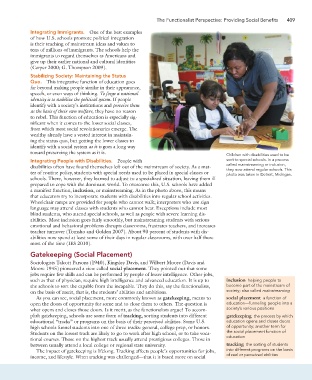Page 436 - Essencials of Sociology
P. 436
The Functionalist Perspective: Providing Social Benefits 409
Integrating Immigrants. One of the best examples
of how U.S. schools promote political integration
is their teaching of mainstream ideas and values to
tens of millions of immigrants. The schools help the
immigrants to regard themselves as Americans and
give up their earlier national and cultural identities
(Carper 2000; G. Thompson 2009).
Stabilizing Society: Maintaining the Status
Quo. This integrative function of education goes
far beyond making people similar in their appearance,
speech, or even ways of thinking. To forge a national
identity is to stabilize the political system. If people
identify with a society’s institutions and perceive them
as the basis of their own welfare, they have no reason
to rebel. This function of education is especially sig-
nificant when it comes to the lower social classes,
from which most social revolutionaries emerge. The
wealthy already have a vested interest in maintain-
ing the status quo, but getting the lower classes to
identify with a social system as it is goes a long way
toward preserving the system as it is. Children with disabilities used to be
Integrating People with Disabilities. People with sent to special schools. In a process
disabilities often have found themselves left out of the mainstream of society. As a mat- called mainstreaming or inclusion,
they now attend regular schools. This
ter of routine policy, students with special needs used to be placed in special classes or photo was taken in Detroit, Michigan.
schools. There, however, they learned to adjust to a specialized situation, leaving them ill
prepared to cope with the dominant world. To overcome this, U.S. schools have added
a manifest function, inclusion, or mainstreaming. As in the photo above, this means
that educators try to incorporate students with disabilities into regular school activities.
Wheelchair ramps are provided for people who cannot walk; interpreters who use sign
language may attend classes with students who cannot hear. Exceptions include most
blind students, who attend special schools, as well as people with severe learning dis-
abilities. Most inclusion goes fairly smoothly, but mainstreaming students with serious
emotional and behavioral problems disrupts classrooms, frustrates teachers, and increases
teacher turnover (Tomsho and Golden 2007). About 90 percent of students with dis-
abilities now spend at least some of their days in regular classrooms, with over half there
most of the time (IES 2010).
Gatekeeping (Social Placement)
Sociologists Talcott Parsons (1940), Kingsley Davis, and Wilbert Moore (Davis and
Moore 1945) pioneered a view called social placement. They pointed out that some
jobs require few skills and can be performed by people of lesser intelligence. Other jobs,
such as that of physician, require high intelligence and advanced education. It is up to inclusion helping people to
the schools to sort the capable from the incapable. They do this, say the functionalists, become part of the mainstream of
on the basis of merit, that is, the students’ abilities and ambitions. society; also called mainstreaming
As you can see, social placement, more commonly known as gatekeeping, means to social placement a function of
open the doors of opportunity for some and to close them to others. The question is education—funneling people into a
what opens and closes those doors. Is it merit, as the functionalists argue? To accom- society’s various positions
plish gatekeeping, schools use some form of tracking, sorting students into different gatekeeping the process by which
educational “tracks” or programs on the basis of their perceived abilities. Some U.S. education opens and closes doors
high schools funnel students into one of three tracks: general, college prep, or honors. of opportunity; another term for
Students on the lowest track are likely to go to work after high school, or to take voca- the social placement function of
tional courses. Those on the highest track usually attend prestigious colleges. Those in education
between usually attend a local college or regional state university. tracking the sorting of students
The impact of gatekeeping is lifelong. Tracking affects people’s opportunities for jobs, into different programs on the basis
income, and lifestyle. When tracking was challenged—that it is based more on social of real or perceived abilities

